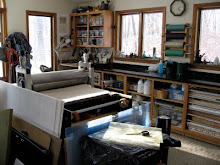I photograph my drawings and size them in PhotoShop. A laser printer is used to print the images onto Mylar. I tweak the film positives by adding additional drawing with a Stablio pencil and a bit of high-lighting the details.
The plates are prepared by adhering the ImagOn to a plastic substrate. I had already determined the exposure times needed for this particular image so things moved along pretty quickly: expose the plate to an aquatint screen, expose the image, process the plate in a soda ash bath, and then dry with a heat gun.
The next morning the plates were ready to proof. I was happy with some of the results but others were quickly scrapped. An advantage of working with ImagOn is that I can reclaim the plastic substrate by removing the film in a soda ash bath, reapply film and create a new plate. This can be done fairly quickly so I can keep the momentum going.
My most recent proofs are exploring background color using a relief plate made from Sintra which is a rigid PVC plastic sheet. (www.lairdplastics.com/product/brands/sintra/267-sintrar)
As the image evolved, I made changes to the drawings, played around with the backgrounds, layers, color options and the possibility of adding a dimensional element; a crocheted "nest". I'm still not sure where I'll end up but such is the creative journey and each proof brings me closer to a resolution.























